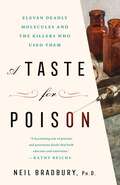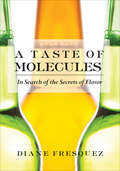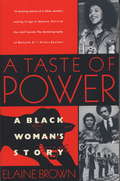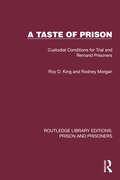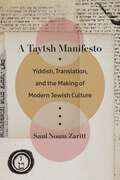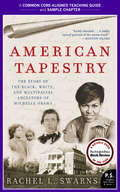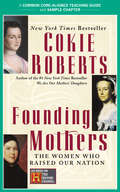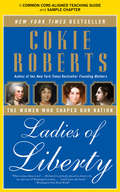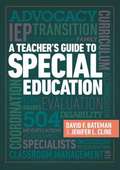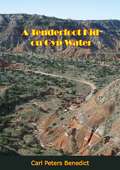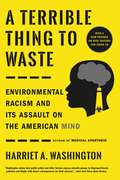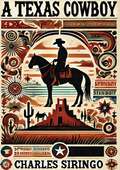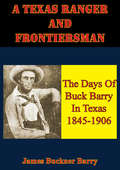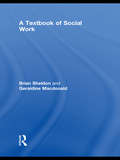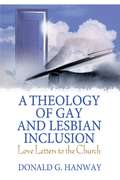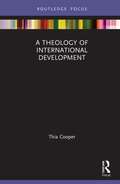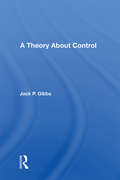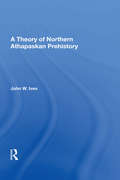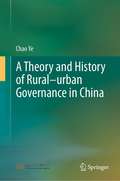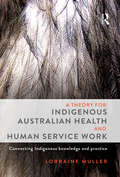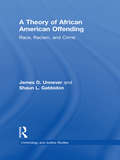- Table View
- List View
A Taste for Poison: Eleven Deadly Molecules and the Killers Who Used Them
by Neil Bradbury“A fascinating tale of poisons and poisonous deeds which both educates and entertains.” --Kathy ReichsA brilliant blend of science and crime, A TASTE FOR POISON reveals how eleven notorious poisons affect the body--through the murders in which they were used. As any reader of murder mysteries can tell you, poison is one of the most enduring—and popular—weapons of choice for a scheming murderer. It can be slipped into a drink, smeared onto the tip of an arrow or the handle of a door, even filtered through the air we breathe. But how exactly do these poisons work to break our bodies down, and what can we learn from the damage they inflict? In a fascinating blend of popular science, medical history, and true crime, Dr. Neil Bradbury explores this most morbidly captivating method of murder from a cellular level. Alongside real-life accounts of murderers and their crimes—some notorious, some forgotten, some still unsolved—are the equally compelling stories of the poisons involved: eleven molecules of death that work their way through the human body and, paradoxically, illuminate the way in which our bodies function. Drawn from historical records and current news headlines, A Taste for Poison weaves together the tales of spurned lovers, shady scientists, medical professionals and political assassins to show how the precise systems of the body can be impaired to lethal effect through the use of poison. From the deadly origins of the gin & tonic cocktail to the arsenic-laced wallpaper in Napoleon’s bedroom, A Taste for Poison leads readers on a riveting tour of the intricate, complex systems that keep us alive—or don’t.
A Taste of Molecules: In Search of the Secrets of Flavor (Women Writing Science Ser.)
by Diane FresquezA delicious exploration of what creates the flavors we love—and why our taste buds respond to them—in a fascinating, &“very pleasant and easy read&” (Flanders Today). In this unique scientific study of food, drink, and how the human taste buds sense taste, food journalist Diane Fresquez brings readers along on a journey of gastronomic discovery. She begins by following a Belgian beekeeper who uses science to give the ancient drink of mead (or &“honey wine&”) a modern taste-makeover. Fresquez then travels to Holland to learn how food memories are tested at a research center called the Restaurant of the Future. And elsewhere, she discovers how much skill it takes to make banana flavor in the lab, and experiments on a group of scientists during a surprise meal eaten in the dark. Stuffed with fascinating food facts, anecdotes from the author&’s own culinary life, and a selection of irresistible recipes (including a cocktail with dancing molecules), A Taste of Molecules is an exploration of the senses that will delight foodies and science enthusiasts alike.
A Taste of Power
by Elaine BrownBrown's account of her life at the highest levels of the Black Panther party's hierarchy. More than a journey through a turbulent time in American history, this is the story of a black woman's battle to define herself.
A Taste of Prison: Custodial Conditions for Trial and Remand Prisoners (Routledge Library Editions: Prison and Prisoners)
by Roy D. King Rodney MorganOriginally published in 1976, A Taste of Prison deals with a very sensitive area of concern in the system of trial and imprisonment in Britain at the time. It describes the conditions at Winchester Prison and Winchester Remand Centre for both adults and young persons who were held in custody before trial or who were awaiting sentence. Despite the fact that many of these persons would not subsequently be sent to prison by the courts, the conditions they experienced were in many respects no better and in some respects worse than those for persons sentenced to imprisonment. Moreover, as this study shows, the special provisions for these persons embodied in the Prison Rules and Standing Orders of the Prison Department often meant little in practice – either because they remained unaware of their rights or because they were unable to take them up for various reasons. The authors discuss the function of remands in custody within a changing prison system, analyse recent trends in the numbers of persons received into the prison system on remand, and assess their contribution to the prison population. The implications of the findings are discussed in the context of the prison building programme and the uses to which existing buildings could be put. Finally, the authors make a number of proposals for the improvement of the regime for remand prisoners.
A Taytsh Manifesto: Yiddish, Translation, and the Making of Modern Jewish Culture
by Saul Noam ZarittA Taytsh Manifesto calls for a translational paradigm for Yiddish studies and for the study of modern Jewish culture. Saul Noam Zaritt calls for a shift in vocabulary, from Yiddish to taytsh, in order to promote reading strategies that account for the ways texts named as Jewish move between languages and cultures. Yiddish, a moniker that became dominant only in the early twentieth century, means “Jewish” and thus marks the language with a single identity: of and for a Jewish collective. In contrast, this book calls attention to an earlier and, at one time, more common name for the language: taytsh, which initially means “German.” By using the term taytsh, speakers indicated that they were indeed speaking a Germanic language, a language that was not entirely their own. In time, when the word shifted to a verb, taytshn, it came to mean the act of translation. To write or speak in Yiddish is thus to render into taytsh and inhabit the gap between languages.A Taytsh Manifesto highlights the cultural porousness that inheres in taytsh and deploys the term as a paradigm that can be applied to a host of modern Jewish cultural formations. The book reads three corpora in modern Yiddish culture through the lens of translation: Yiddish pulp fiction, also known as shund (trash); the genre of the Yiddish monologue as authored by Sholem Aleichem and other prominent Yiddish writers; and the persistence of Yiddish as a language of vulgarity in contemporary U.S. culture. Together these examples help revise current histories of Yiddish while demonstrating the need for new vocabularies to account for the multidirectionality of Jewish culture. A Taytsh Manifesto develops a model for identifying, in Yiddish and beyond, how cultures intertwine, how they become implicated in world systems and empire, and how they might escape such limiting and oppressive structures.
A Teacher's Guide to American Tapestry
by Rachel L. Swarns Amy JurskisFor teachers We know that the Common Core State Standards are encouraging you to reevaluate the books that you assign to your students. To help you decide which books are right for your classroom, each free ebook in this series contains a Common Core-aligned teaching guide and a sample chapter.This free teaching guide for An American Tapestry by Rachel L. Swarns is designed to help you put the new Common Core State Standards into practice."Riveting. . . . A microcosm of this country's story. . . . The real-life saga of struggle, survival, triumph and tragedy serves as an uplifting companion to Alex Haley's Roots."--USA TodayIn this extraordinary feat of genealogical research, author Swarns, a respected Washington-based reporter for the New York Times, tells the fascinating and hitherto untold story of Ms. Obama's black, white, and multiracial ancestors; a history that the First Lady herself did not know.At once epic, provocative, and inspiring, American Tapestry is more than a true family saga; it is an illuminating mirror in which we may all see ourselves.
A Teacher's Guide to Founding Mothers
by Cokie Roberts Amy JurskisFor teachersWe know that the Common Core State Standards are encouraging you to reevaluate the books that you assign to your students. To help you decide which books are right for your classroom, each free ebook in this series contains a Common Core-aligned teaching guide and a sample chapter.This free teaching guide for Founding Mothers by Cokie Roberts is designed to help you put the new Common Core State Standards into practice."Instructive and inspiring."--New York Times Book ReviewDrawing upon personal correspondence, private journals, and even favored recipes, Roberts reveals the often surprising stories of these fascinating women, bringing to life the everyday trials and extraordinary triumphs of individuals like Abigail Adams, Mercy Otis Warren, Deborah Read Franklin, Eliza Pinckney, Catherine Littlefield Green, Esther DeBerdt Reed, and Martha Washington--proving that without our exemplary women, the new country might never have survived.
A Teacher's Guide to Ladies of Liberty
by Cokie Roberts Amy JurskisFor teachersWe know that the Common Core State Standards are encouraging you to reevaluate the books that you assign to your students. To help you decide which books are right for your classroom, each free ebook in this series contains a Common Core-aligned teaching guide and a sample chapter.This free teaching guide for Ladies of Liberty by Cokie Roberts is designed to help you put the new Common Core State Standards into practice."Roberts weaves a colorful story of the trials and triumphs of the women of the post-Revolution. . . . Ladies of Liberty is not only informative but entertaining."--Denver PostRecounted with insight and humor, and drawing on personal correspondence, private journals, and other primary sources, many of them previously unpublished, here are the fascinating and inspiring true stories of first ladies and freethinkers, educators and explorers.Featuring an exceptional group of women--including Abigail Adams, Dolley Madison, Rebecca Gratz, Louise Livingston, Sacagawea, and others--Ladies of Liberty sheds new light on the generation of heroines, reformers, and visionaries who helped shape our nation, finally giving these extraordinary ladies the recognition they so greatly deserve.
A Teacher's Guide to Special Education
by David Bateman Jenifer ClineDespite the prevalence of students with disabilities in the general education classroom, few teachers receive training on how to meet these students' needs or how to navigate Despite the prevalence of students with disabilities in the general education classroom, few teachers receive training on how to meet these students' needs or how to navigate the legally mandated processes enumerated in the Individuals with Disabilities Education Act (IDEA). What is their role? What are their responsibilities? What are the roles and rights of parents? And what must all teachers do to ensure that students with disabilities and other special needs receive the quality education they're entitled to? In this practical reference, David F. Bateman--bestselling author of A Principal's Guide to Special Education --and special education administrator Jenifer L. Cline clarify what general education teachers need to know about special education law and processes and provide a guide to instructional best practices for the inclusive classroom. Topics covered include The pre-referral, referral, and evaluation processes Individualized education programs (IEPs) and the parties involved Accommodations for students who do not quality for special education, including those covered by Section 504 Transition from preK to K-12 and from high school to postschool life Classroom management and student behavior Educational frameworks, instructional strategies, and service delivery options Assessment, grades, graduation, and diplomas The breadth of coverage in this book, along with its practical examples, action steps, and appendixes covering key terms and definitions will provide the foundation all K-12 teachers need to successfully instruct and support students receiving special education services. It's an indispensable resource for every general education classroom. the legally mandated processes enumerated in the Individuals with Disabilities Education Act (IDEA). What is their role? What are their responsibilities? What are the roles and rights of parents? And what must all teachers do to ensure that students with disabilities and other special needs receive the quality education they're entitled to? In this practical reference, David F. Bateman--bestselling author of A Principal's Guide to Special Education --and special education administrator Jenifer L. Cline clarify what general education teachers need to know about special education law and processes and provide a guide to instructional best practices for the inclusive classroom. Topics covered include The pre-referral, referral, and evaluation processes Individualized education programs (IEPs) and the parties involved Accommodations for students who do not quality for special education, including those covered by Section 504 Transition from preK to K-12 and from high school to postschool life Classroom management and student behavior Educational frameworks, instructional strategies, and service delivery options Assessment, grades, graduation, and diplomas The breadth of coverage in this book, along with its practical examples, action steps, and appendixes covering key terms and definitions will provide the foundation all K-12 teachers need to successfully instruct and support students receiving special education services. It's an indispensable resource for every general education classroom.
A Technomoral Politics: Good Governance, Transparency, and Corruption in India
by Aradhana SharmaExamining anticorruption battles and transparency laws to ask: what makes for good governance, and can it limit liberal democratic politics as much as encourage it? Good governance is meant to empower citizens, increase democratic participation, and make states transparent and accountable, yet this liberal democratic imperative can also promote populist authoritarian rule. Bringing together discourses on ethical goodness with the technicalities of governance as expressed in laws and policies, Aradhana Sharma develops the concept of &“technomoral politics&” to navigate this fraught topic. With a focus on the work of activists, citizens, and state officials, she offers an ethnographic account of the contradictions and dangers of good-governance politics in twenty-first-century India. A Technomoral Politics follows the evolution of a group of activists in New Delhi led by Arvind Kejriwal from 2008 to 2014 as they morphed from a protransparency NGO to a mass movement against state corruption to a populist party that promised to change the political system through laws and policies. Sharma explores the technomoral framing of state opacity and corruption as well as the limits of the law in resolving these issues, probing such themes as the contradictory relationship between transparency and bureaucracy and the classed and gendered nature of democratic state institutions. By examining scalar dimensions of good-governance politics, from the hyperlocal work of activists to global trends, A Technomoral Politics illuminates the paradoxes, limits, and risks of a system that is meant to spread liberal democratic principles but that also ends up promoting antidemocratic, populist-authoritarian forms of rule. Retail e-book files for this title are screen-reader friendly.
A Tenderfoot Kid on Gyp Water
by Carl Peters BenedictStill wet behind the ears in 1894, Carl Benedict was “crazy to get away and work on the range.” In the summer, he hooked up with a big outfit called the Figure 8 to round up cattle in the Texas Panhandle. Out of that experience came this book, published fifty years later, about what it was really like to be a cowboy in some ornery country checkered by canyons and gyp water springs.A Tenderfoot Kid on Gyp Water is all the more engaging for being unpretentious. During daily drives, the Kid learns how to ride, rope, brand, and hobble cattle and horses. The cowboys who teach him are not stereotyped or romanticized. Life on the range is too immediate and real to require Hollywood heroics. But every day brings drama: blockbuster fights of fierce wild bulls, treacherous river crossings with thousands of cattle in the water at once. Some nights bring thunderstorms and stampedes. And through it all those “cattle, horses, and also men who were not physically fit and healthy soon died or disappeared.”“One of the best books ever written on the Texas range.”—William S. Reese, Six Score: The 120 Best Books on the Range Cattle Industry.“Intelligence, [a] sense of humor, rightness of heart, observant sympathy for nature, and gentle sensitiveness [are] manifest throughout A Tenderfoot Kid on Gyp Water.”—J. Frank Dobie.
A Terrible Thing to Waste: Environmental Racism and Its Assault on the American Mind
by Harriet Washington<P><P>Did you know...Middle-class African American households with incomes between $50,000 and $60,000 live in neighborhoods that are more polluted than those of very poor white households with incomes below $10,000. <P><P>When swallowed, a lead-paint chip no larger than a fingernail can send a toddler into a coma -- one-tenth of that amount will lower his IQ. <P><P>Nearly two of every five African American homes in Baltimore are plagued by lead-based paint. Almost all of the 37,500 Baltimore children who suffered lead poisoning between 2003 and 2015 were African American.From injuries caused by lead poisoning to the devastating effects of atmospheric pollution, infectious disease, and industrial waste, Americans of color are harmed by environmental hazards in staggeringly disproportionate numbers. <P><P>This systemic onslaught of toxic exposure and institutional negligence causes irreparable physical harm to millions of people across the country-cutting lives tragically short and needlessly burdening our health care system. But these deadly environments create another insidious and often overlooked consequence: robbing communities of color, and America as a whole, of intellectual power. <P><P>The 1994 publication of The Bell Curve and its controversial thesis catapulted the topic of genetic racial differences in IQ to the forefront of a renewed and heated debate. <P><P>Now, in A Terrible Thing to Waste, award-winning science writer Harriet A. Washington adds her incisive analysis to the fray, arguing that IQ is a biased and flawed metric, but that it is useful for tracking cognitive damage. <P><P>She takes apart the spurious notion of intelligence as an inherited trait, using copious data that instead point to a different cause of the reported African American-white IQ gap: environmental racism - a confluence of racism and other institutional factors that relegate marginalized communities to living and working near sites of toxic waste, pollution, and insufficient sanitation services. <P><P>She investigates heavy metals, neurotoxins, deficient prenatal care, bad nutrition, and even pathogens as chief agents influencing intelligence to explain why communities of color are disproportionately affected -- and what can be done to remedy this devastating problem. Featuring extensive scientific research and Washington's sharp, lively reporting, A Terrible Thing to Waste is sure to outrage, transform the conversation, and inspire debate.
A Test of the General Validity of the Heckscher-Ohlin Theorem for Trade in the European Community
by Dalia HakuraA report from the International Monetary Fund.
A Texas Cowboy, or, Fifteen Years on the Hurricane Deck of a Spanish Pony [Illustrated Definite 1950 edition]
by Charles Siringo"A Texas Cowboy, or, Fifteen Years on the Hurricane Deck of a Spanish Pony [Illustrated Definite 1950 edition]" by Charles Siringo is a thrilling and authentic account of life in the American West, capturing the essence of the cowboy experience during the late 19th century. This definitive 1950 edition, enhanced with illustrations, brings Siringo's vivid tales to life, offering readers a compelling glimpse into the rugged and adventurous world of the Texas cowboy.Charles Siringo, a legendary figure in Western history, chronicles his fifteen years as a cowboy, providing an unparalleled insider's perspective on the trials, triumphs, and tribulations of life on the open range. From cattle drives across vast prairies to encounters with notorious outlaws, Siringo's narrative is filled with exciting episodes and colorful characters that paint a vivid picture of the Old West.The book covers various aspects of cowboy life, including the hard work, camaraderie, and the constant challenges posed by the untamed landscape and unpredictable weather. Siringo's writing is characterized by its authenticity and straightforward style, reflecting his genuine experiences and deep connection to the cowboy way of life. He shares not only the adventurous aspects of his career but also the personal moments of reflection and growth, offering a well-rounded portrayal of his journey."A Texas Cowboy" is more than just an adventure tale; it is a historical document that provides valuable insights into the culture and ethos of the American cowboy. This illustrated definitive edition is a must-read for history enthusiasts, Western aficionados, and anyone interested in the true stories of the American frontier.Charles Siringo's memoir stands as a testament to the enduring spirit of the cowboy and the rich legacy of the American West. With its engaging narrative and evocative illustrations, "A Texas Cowboy" continues to captivate and inspire readers, preserving the spirit of a bygone era.
A Texas Pioneer: Early Staging And Overland Freighting Days On The Frontiers Of Texas And Mexico
by August SantlebenStep into the rugged and adventurous world of the American frontier with August Santleben's A Texas Pioneer. This compelling autobiography offers an intimate and vivid account of life in 19th-century Texas, as experienced by one of its most colorful and resilient pioneers.August Santleben, a true frontiersman, recounts his journey from his early days as an immigrant to his ventures across the vast and untamed landscapes of Texas. A Texas Pioneer is rich with personal anecdotes and historical insights, capturing the challenges, dangers, and triumphs of pioneer life. Santleben's engaging narrative brings to life the spirit of exploration and determination that defined the era.Throughout the book, readers will encounter a wide array of experiences, from encounters with Native American tribes and battles with bandits to the daily struggles of ranching and farming. Santleben's detailed descriptions and heartfelt storytelling provide a genuine portrayal of the hardships and rewards of frontier life.A Texas Pioneer, also delves into significant historical events and figures that shaped Texas during the 19th century. Santleben offers a unique perspective on the social, political, and economic developments of the time, making this autobiography not only a personal memoir but also a valuable historical document.This book is an essential read for history enthusiasts, students of American history, and anyone fascinated by the pioneer spirit. August Santleben's A Texas Pioneer is a testament to the courage, ingenuity, and resilience of the individuals who helped shape the American West.Join August Santleben on his incredible journey through the wilds of Texas, and experience the adventures and challenges of a true Texas pioneer. A Texas Pioneer is a timeless and inspiring account that brings the rich history of the Lone Star State to life.
A Texas Ranger And Frontiersman: The Days Of Buck Barry In Texas 1845-1906
by James Buckner Barry"Although Jim Bowie and Davy Crockett were more celebrated, Buck Barry did as much or more to tame the Old Southwest. During a long and useful life he was a professional soldier, stock farmer, sheriff, and member of the legislature. His memoirs are never dull, and no wonder. In 1845 young James Buckner Barry joined the newly formed Texas Rangers and for the next twenty years his life was one of unremitting activity and danger. These pages show him fighting outlaws and Indians from the Red River to the Rio Grande. He served in the Mexican and Civil wars, coming out as a lieutenant colonel. Then he confronted the daily perils of ranching in Bosque County, Texas. Peace officer, legislator, "he served his people well even to the neglect of his private advantage." Such is the tribute of the historian James K. Greer, who edited Buck Barry's private papers and reminiscences and shaped them into this book."-Print ed.
A Textbook of Social Work
by Geraldine Macdonald Brian SheldonWhere did professional social work originate from? How effective are social work interpretations in the lives of vulnerable people? A Textbook of Social Work provides a comprehensive discussion of social work practice and its evidence-base. It strikes a balance between the need for social workers to understand the social, economic, cultural, psychological and interpersonal factors which give rise to clients’ problems, and the need for them to know how best to respond with practical measures. Divided into three parts: the text covers the history and of social work as a movement and profession in the first, and social work methods and approaches in the second. The final part looks at the major specialisms, including, among others, chapters on: Children and families Youth Offenders and substance misusers Social work and mental health Disabled people Older People Providing a comprehensive guide to conceptual and methodological issues in social work and containing plentiful case studies and examples, this book is an essential read for social work students, as well as a valuable resource for practitioners and academics.
A Theology of Gay and Lesbian Inclusion: Love Letters to the Church
by Donald G HanwayEncourage the Church to address the gift of human sexuality-how to view it, how to deal with it, and how it relates to spiritualityA Theology of Gay and Lesbian Inclusion: Love Letters to the Church challenges traditional church teachings that brand homosexuality as immoral, using pertinent scripture from the central Gospel to promote a full acceptance of gay and lesbian Christians. This powerful book questions the assumption that gay Christians are morally inferior, presenting testimony from gay men and lesbians about prejudice they&’ve experienced at the hands of the Church-and its straight members. Written as a series of ten letters, the book addresses the strengths and weaknesses of the church and appeals for a new understanding and commitment to the acceptance of its gay members. From the author:The purpose of this book is to equip you, Christian warrior of the Gospel of peace, to stand against those who use the Bible to resist change-even that change of which our Lord would approve. In one sense, there is nothing revolutionary about this book. It is a book that respects tradition-but only up to a point: that point where tradition has to change, to give way to what the Holy Spirit is showing us in our day of the mind of Christ. And this is not revolutionary, because tradition has had to change before; it is a developing truth, born of the corporate experience of the children of God, and open to our claiming the exercise of our God-given gift of reason. A Theology of Gay and Lesbian Inclusion includes a series of letters that progress from establishing the purpose and credibility of the author, to developing grounding in Scripture and experience, to appealing to the reader to act as an ally of gay and lesbian Christians. The letters include: "Dear Christian Believer," which aims for the "bull&’s-eye" of the reader&’s faith "Dear Sexual Being," which offers a fresh look at a sensitive topic "Dear Confused Church Member," which discusses what gay people are "really" like "Dear Concerned Church Member," which discusses what gay people really want "Dear Bible Explorer," which discusses what the Bible really says "Dear Person Trying to Do the Right Thing," from "being" to "doing" and much moreA Theology of Gay and Lesbian Inclusion provides a friendly and informal Biblical rationale for alternatives to traditional church teachings, encouraging the acceptance of gay and lesbian people as fully moral and fully Christian.
A Theology of International Development (Routledge Research in Religion and Development)
by Thia CooperReligion and development have been intertwined since development's beginnings, yet faith-based aid and development agencies consistently fail to consider how their theology and practice intersect. This book offers a Christian theology of development, with practical solutions to bridge the gap and return to truly faith-based policies and practices. Development aims to raise the living standard of the world’s poor, mainly through small-scale projects that increase economic growth. A theology of liberation provided a critique to development practice, but a specific theology of development is still lacking, and many faith-based aid agencies have failed to adapt their practice. In applying theological thinking to development, the author argues that aid agencies need to address the entrenchment of unequal power relations, and embrace a holistic notion of development, defined by the needs of those most marginalized, instead of by a focus on economic growth. Development organisations need to consider the distinction between charity and justice, and to empower people in the Global South, paying particular attention to the intersections of race, class, sexuality, religion, and the environment. Overall this book is a powerful call to upend development practice as it currently exists and to return faith-based organizations to following Christian practices. It will be an important read for religion and development researchers, practitioners, and students.
A Theory About Control
by Jack P. GibbsMoving beyond his 1989 book, Control: Sociology's Central Notion, Jack Gibbs develops in this new book a comprehensive theory of control in all its biological, technological, and human dimensions. His treatment goes beyond conventional ideas about social control to show why self-control and proximate control are essential to understanding human interaction. He also argues that thinking of control in terms of the counteraction of deviance is insufficient. Tests of Gibbs's control theory, based on data from sixty-six countries, add credence to his claim that control could be the central notion for sociology and perhaps for other social sciences.
A Theory Of Northern Athapaskan Prehistory
by John W IvesThis book explores the conceptual basis for the events and processes in the prehistory of the Athapaskans, one of the most wide-spread peoples in western North America. The author bases his research on the premise that social structure is not passively dependent on the technological and economic bases of society, and argues that, ultimately, kinshi
A Theory and History of Rural–urban Governance in China
by Chao YeThis book divides the history of China's rural-urban relations into three stages: antagonism, integration and re-antagonism, and demonstrates that the two coupled variables i.e., policy-culture and coast-trade are the most crucial to urbanization and rural-urban governance in China from ancient times till now. From the perspective of a combination of history and geography, this book puts forward a new theory which is mainly based on Adam Smith's theory and other theories about rural-urban relationship and reinterprets the process and driving forces of evolutionary history of rural-urban relationship over 5,000 years in China. It is useful for researchers and scholars specialized in such fields as rural and urban studies, economics, geography, management and planning for reference.
A Theory for Indigenous Australian Health and Human Service Work: Connecting Indigenous knowledge and practice
by Lorraine MullerWinner of the 2015 Educational Publishing Awards Australia - Scholarly ResourceMost people of European background are not aware that they see the world through the lens of the Western tradition, but for Indigenous people, it can seem like a foreign language.Indigenous ways of thinking and working are grounded in many thousands of years of oral tradition, and continue among Australian Aboriginal and Torres Strait Island people today. Lorraine Muller shows that understanding traditional holistic approaches to social and emotional wellbeing is essential for practitioners working with Indigenous clients across the human services. She explores core principles of traditional Indigenous knowledge in Australia, including relatedness, Country, circular learning, stories, and spirituality. She then shows how these principles represent a theory for Indigenous practice.A Theory for Indigenous Australian Health and Human Service Work offers a deep insight into Indigenous Australian ways of working with people, in the context of a decolonisation framework. It is an invaluable resource for both Indigenous and non-Indigenous practitioners and researchers in health, social work, community work, education and related fields.'In today's global environment, where Indigenous Peoples continue to fight for self-determination, Muller's work is an exemplary model of Indigenous self- determination. It is bound to be a foundational model of Indigenous practice in field of health and well-being.' - Michael Hart, Canada Research Chair in Indigenous Knowledges and Social Work, University of Manitoba'Lorraine Muller's work covers some centrally important issues for those that work with Aboriginal and Torres Strait Islander people, and who want to understand indigenous knowledge frameworks.' - Dr Mark Wenitong, Apunipima Cape York Health Council
A Theory of African American Offending: Race, Racism, and Crime (Criminology and Justice Studies)
by Shaun L. Gabbidon James D. UnneverA little more than a century ago, the famous social scientist W.E.B. Du Bois asserted that a true understanding of African American offending must be grounded in the "real conditions" of what it means to be black living in a racial stratified society. Today and according to official statistics, African American men – about six percent of the population of the United States – account for nearly sixty percent of the robbery arrests in the United States. To the authors of this book, this and many other glaring racial disparities in offending centered on African Americans is clearly related to their unique history and to their past and present racial subordination. Inexplicably, however, no criminological theory exists that fully articulates the nuances of the African American experience and how they relate to their offending. In readable fashion for undergraduate students, the general public, and criminologists alike, this book for the first time presents the foundations for the development of an African American theory of offending.
A Theory of Assembly: From Museums to Memes
by Kyle ParryA vital reckoning with how we understand the basic categories of cultural expression in the digital era Digital and social media have transformed how much and how fast we communicate, but they have also altered the palette of expressive strategies: the cultural forms that shape how citizens, activists, and artists speak and interact. Most familiar among these strategies are storytelling and representation. In A Theory of Assembly, Kyle Parry argues that one of the most powerful and pervasive cultural forms in the digital era is assembly.Whether as subtle photographic sequences, satirical Venn diagrams, or networked archives, projects based in assembly do not so much narrate or represent the world as rearrange it. This work of rearranging can take place at any scale, from a simple pairing of images, undertaken by one person, to the entire history of internet memes, undertaken by millions. With examples ranging from GIFs and paintings to museum exhibitions and social movement hashtags, Parry shows how, in the internet age, assembly has come to equal narrative and representation in its reach and influence, particularly as a response to ecological and social violence. He also emphasizes the ambivalence of assembly—the way it can be both emancipatory and antidemocratic.As the world becomes ever hotter, more connected, and more algorithmic, the need to map—and remake—assembly&’s powers and perils becomes all the more pressing. Interdisciplinary, engaging, and experimental, A Theory of Assembly serves as a playbook of strategies and critical frameworks for artists, activists, and content creators committed to social and environmental justice, ultimately arguing for a collective reenvisioning of which cultural forms matter.Cover alt text: Letters from the title appear in a jumble, each colored in a blue-orange gradient. Readable title and author sits below the jumble.
